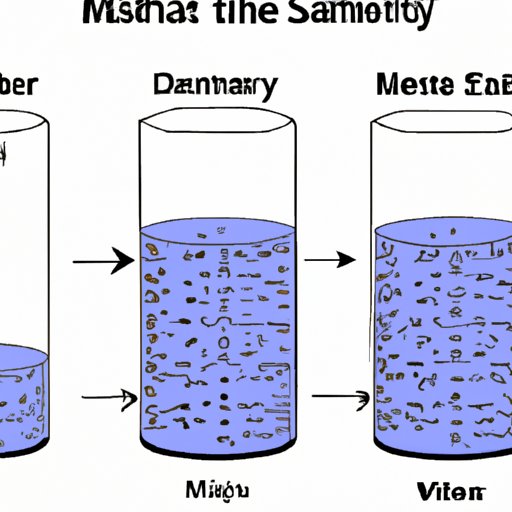
Introduction
Density is defined as the amount of matter packed into a given volume of space. It is essential for understanding the physical properties of different materials and how they interact with the environment. Knowing the density of a material can provide valuable insights into its weight, buoyancy, and strength. This article explores how to find density with mass and volume, the importance of understanding density, and practical applications of density calculations.
The Simple Guide to Finding Density with Mass and Volume
Mass is the measure of how much matter is present in an object, while volume is the amount of space that an object occupies. Measuring mass and volume is an essential first step in finding density. A balance or scale can be used to measure mass, while a graduated cylinder or other measuring tools can be used to determine volume.
The formula for finding density is simply dividing mass by volume:
Density = mass/volume
For example, a block of metal weighs 500 grams and has a volume of 250 cubic centimeters. To find its density, divide the mass by volume:
Density = 500 g / 250 cc = 2 g/cc
Common mistakes to avoid when finding density with mass and volume include using incorrect units or measurements and inaccurate weighing or measuring techniques. It’s crucial to check and double-check your measurements to avoid errors.
Mastering Density: A Step-by-Step Process with Mass and Volume
For more accurate density calculations, it’s essential to follow a more detailed process:
- Weigh the object and record the mass measurement.
- Measure the object’s volume, either by displacement or by formula.
- Divide the mass by the volume to find the object’s density in grams per cubic centimeter (g/cc).
- Compare the density to known materials and determine what the object might be made of.
Accurate measurements are vital to achieving accurate density results. Use calibrated instruments and follow instructions for measuring techniques. Practical tips for ensuring accuracy include using a clean and dry measuring container, and taking the average of multiple measurements.
The Importance of Understanding Density and How to Calculate it with Mass and Volume
Density has numerous applications in real-world settings, including transportation, agriculture, and construction. For example, knowing the density of materials in transportation helps to maximize cargo capacity. In agriculture, density measurements help farmers to fertilize soils accurately. In construction, density measurements help engineers to design stable structures.
To calculate the density of irregularly shaped objects, use water displacement. Fill a container partially with water and place the object in the water. Record the volume of water displaced by the object, then divide the mass of the object by the volume of water displaced to find its density.
Examples of the importance of density calculations include calculating the density of a hot air balloon, which requires considering the volume of air heated inside the balloon, and finding the density of sea ice, which helps to determine the impact of climate change on ocean currents.
From Molecules to Objects: Calculating Density with Mass and Volume
Density is related to the molecular structure of a material. For instance, materials with a more tightly packed, closer molecular structure are denser than materials with less tightly packed molecular structure. Examples of materials with different densities include cork and steel. Cork has a low density, while steel has a high density.
To calculate the density of mixtures, add the mass of the individual materials, and divide by the total volume of the mixture. Consider the density of each material to determine how they relate to one another.
The impact of temperature on density can be significant, especially when dealing with gases. As temperature increases, the volume of gas expands, leading to a decrease in density. Conversely, as temperature decreases, the volume of gas decreases, leading to an increase in density.
Density 101: Using Mass and Volume to Find the Density of Materials
Density is measured in a range of units, including grams per milliliter (g/mL), grams per cubic centimeter (g/cc), and kilograms per cubic meter (kg/m3). Different materials have different densities. For instance, liquids tend to have densities of around 1-2 g/mL, while solids have densities ranging from 0.2 g/mL to over 19 g/mL.
Comparing the density of different materials is an essential aspect of finding the specific gravity of a substance. Specific gravity is a ratio of a material’s density to the density of another material, usually water. It indicates how heavy or light a material is compared to water.
Maximizing Your Lab Results: Tips for Finding Density with Mass and Volume
To achieve accurate density results, use calibrated instruments and follow instructions for proper weighing and measuring techniques. Use a clean and dry measuring container, and take the average of multiple measurements. Using proper technique and equipment means that density results are more reliable and repeatable.
Exploring the Relationship Between Mass, Volume, and Density: A Practical Guide
From a theoretical standpoint, mass, volume, and density are intimately related. Changing the mass or volume of a material will change its density. For instance, adding more mass to an object while holding volume constant will increase its density. Likewise, adding more volume while holding mass constant will decrease its density.
Density can also be used to determine the identity of an unknown substance. Comparing the density of an unknown material against the known densities of other materials can help to identify the unknown substance. This process is often used in forensic science and environmental analysis.
Conclusion
Understanding density is essential for defining the physical properties of various materials. Measuring mass and volume and using formulas to find density are basic, fundamental techniques for scientists and engineers. By gaining a deep understanding of the relationship between mass, volume, and density, you can learn to effectively build structures, design materials, and analyze data to solve complex problems.




